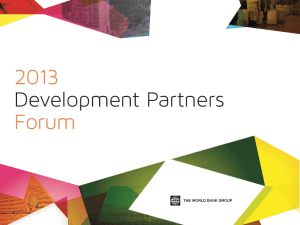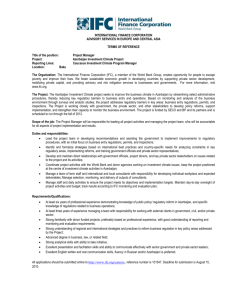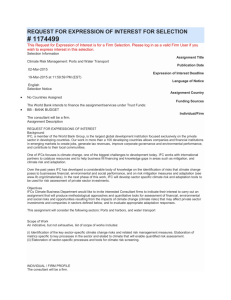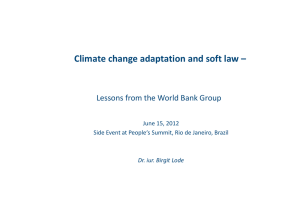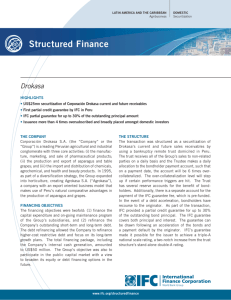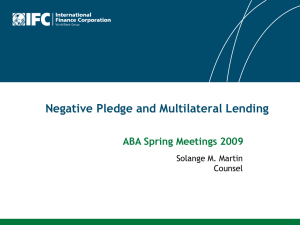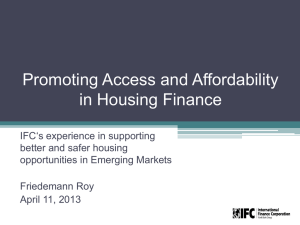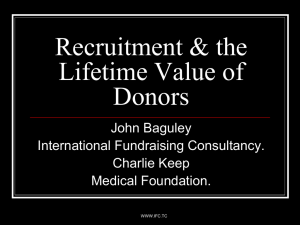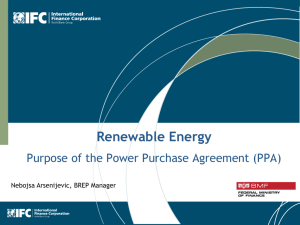Presentation
advertisement
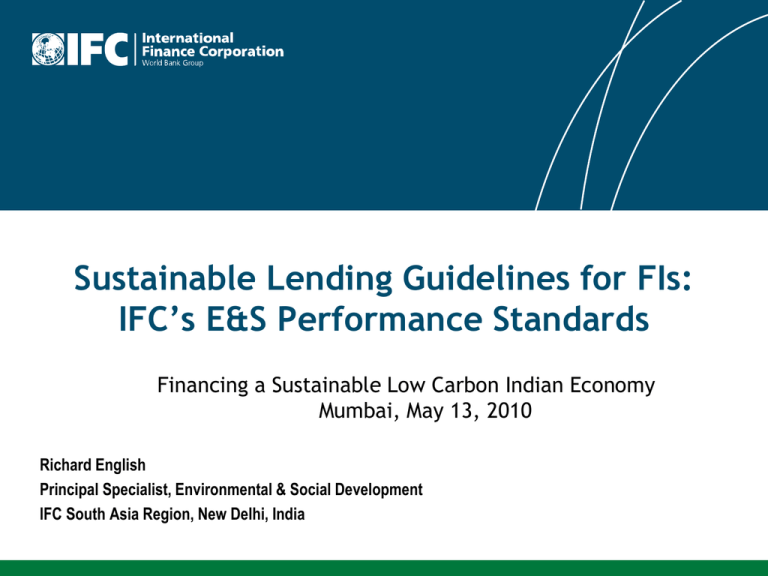
Sustainable Lending Guidelines for FIs: IFC’s E&S Performance Standards Financing a Sustainable Low Carbon Indian Economy Mumbai, May 13, 2010 Richard English Principal Specialist, Environmental & Social Development IFC South Asia Region, New Delhi, India Main Topics • IFC Sustainability Framework & Performance Standards • Rationale for managing E&S risks • What is E&S Risk Management System? • Case examples IFC & Sustainability – Managing Environment & Social Risks • Integrate E&S risk management into business processes For IFC: Sustainability Policy E&S Risk Review and Monitoring Procedures Organization, Responsibilities, Resources, and Training Reporting For Clients: 8 Performance Standards and 63 Environment, Health and Safety Guidelines Applies its Standards and Guidelines to all its investments Training, technical assistance, advisory services Umbrella: PS1: Social and Environmental Assessment & Management Systems PS2 PS3 PS 1 PS4 Labour and Working Conditions Pollution Prevention and Abatement Community, Health, Safety and Security PS5 Land Acquisition and Involuntary Resettlement PS6 Biodiversity Conservation and Sustainable Resource Management PS7 Indigenous Peoples PS8 Cultural Heritage PS 1: Social & Environmental Assessment and Management Systems and Management PS1: Social & Environmental Assessment Systems Objectives & Outcomes: • Identify and assess social and environmental impacts and risks in the project’s area of influence • Avoid if possible, and minimize adverse impacts on affected communities and the environment • Promote improved social and environmental performance through the use of management systems • Ensure affected communities are appropriately engaged PS 2-4: Frequently Used Standards Applicable in almost all projects • PS 2: Core labor standards; working conditions; occupational health and safety; supply chain issues • PS 3: Pollution prevention, resource conservation and energy efficiency; wastes and hazardous materials; green house gases • PS 4: Safety of communities from project activities that can cause accidents, diseases, emergencies PS 5-8: Technical Standards • Less frequently applied • Avoidance or mitigation of: PS 5: Land acquisition and involuntary resettlement- whether physical displacement or economic PS 6: Habitat destruction; management and certification of renewable natural resources (e.g., forests) PS 7: Impacts on Indigenous Peoples when they are adversely affected by the project PS 8: Destruction or damage to cultural heritage E&S Management System and Financial Sector • A systematic framework to integrate E&S risk considerations into a bank’s business processes • Bank develops its own system reflecting: Business environment Investment scope and sizes Staff capabilities Risk exposure/Risk appetite Institutional culture Cumulative IFC Investments in India up to March 2010 ($6.8b) Oil, Gas and Chemicals, $900m Subnational Finance, $50m Agribusiness, $265m Information and Comm. Technologies, $304m Manufacturing, $1,915m Infrastructure, $1,558m Health and Education, $197m Private Equity and Investment Funds, $405m Financial Markets, $1,212m Risks in Banking • Environmental and social risks present themselves to companies and financial institutions as business risks • Main types of risk for banks: • Credit risk (default probability; loss given default) • Liability risk • Reputational risk • Risks present themselves • At the level of single transactions • At the portfolio level 10 Key Social & Environmental Risks Identified by Commercial Banks Reputational risk / Negative publicity with customers, 83 shareholders and the general public Credit risk (defaults, payments rescheduling) 68 49 Security (devalued collateral) 44 Nonperforming loans/investments/leases Loss of financing from international financial 37 institutions Liability for clean up of contaminated 34 property/collateral Reduced access to capital from private financial 27 institutions/international bond market 22 Potential civil or criminal liability for negligence 20 Loss of depositors or retail clients 0 Other 0 10 20 30 40 50 percent 11 60 70 80 90 E&S Management System • There is no one commonly accepted blue print for E&S Management System • Core elements : Environmental and Social Policy E&S Risk Review and Monitoring Procedures Organization, Responsibilities, Resources, and Training Reporting IFC Requirements for Financial Sector Clients • Exclusion List • Local laws and regulations • Industry EHS Guidelines • E&S Management System • Initial screening • Categorization • Due diligence • E&S Covenants (including Action Plan) • Monitoring • Reporting Case Examples • CGPL – 4000 MW Thermal Power • Vicat Sagar Cement – 5 mtpa + 60 MW Thermal CPP • Cairn Energy – Oil field development and pipeline • Pulp & Paper Producers – Supply chain of 200,000+ farmers
